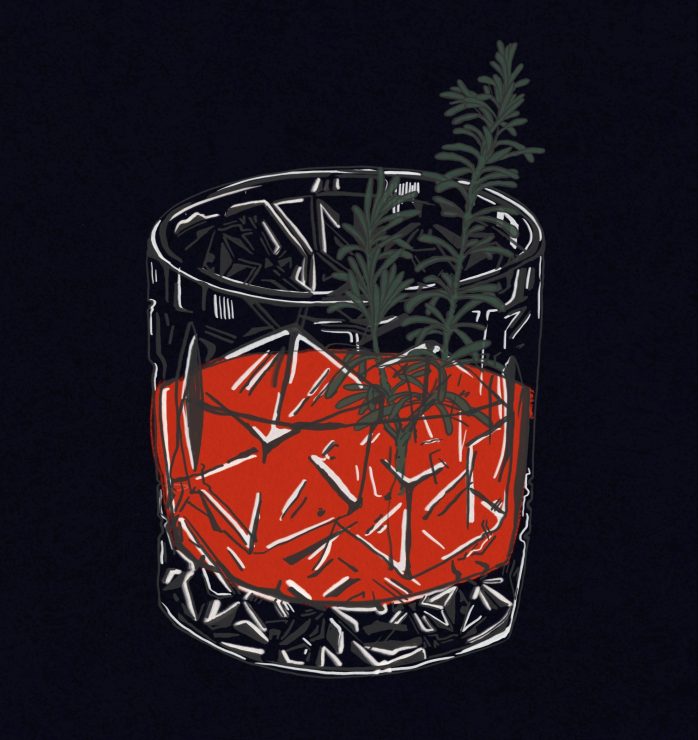UVic expands research on alcohol policy, drinkers expand their tolerances

Illustration by Chloe Latour.
On Sunday, Nov. 5, we will say goodbye to Daylight Saving Time (DST) and hello to a winter season of shorter, darker days — and more booze-drinking.
This is much to the dismay of epidemiologists working to decrease alcohol consumption, such as researchers at UVic’s Canadian Alcohol Policy Evaluation (CAPE) project.
Dr. Michael Pollock, a local expert on circadian cycles, drugs, and behaviour, explains that the transition out of DST in the fall means an almost ten per cent increase in alcohol consumption rates, according to a recent large-scale survey in the United States gathered from a biometric sleep tracking app and surveys of users.
This could mean, as we set our clocks back and welcome colder, darker days starting this week, we may be facing a double affront to our collective resistance against alcohol consumption and overconsumption.
According to Statistics Canada, people aged 20–24 drink the most. Victoria is home to many college and university-aged folks, meaning that the city could be especially prone to a Daylight Savings-induced alcohol surge.
In the study that Pollock references, the reason why our “fall back” into DST increases alcohol consumption may have to do with the correlation between “decreased consistency of sleep timing” and increased alcohol use.
Harvard Health corroborates this, finding that the time change can disrupt sleep and worsen conditions like depression and anxiety, and overall have adverse health effects, both physically and psychologically.
Speculation varies as to why darker days tend to see instances of increased alcohol consumption. Some think it might be to do with self-medicating cases of depression, which are more prevalent during months with less sunlight.
Another speculation is that people drink more when the days grow dimmer and colder simply because social events move indoors, where alcohol is readily available.
“In the winter semesters, I notice that students are definitely more susceptible to giving into peer influences,” says Kyla Allan, a full-time bartender at UVic’s campus pub, Felicita’s.
She attributes this to a lack of activity in darker months. According to Allan, by 7 p.m. on a winter Wednesday, students will concede to a night of drinking more often than they do in summer months.
Changes in consumption patterns, regardless of the cause, are reason for concern for the alcohol epidemiologists at CAPE, given the dangers associated with consuming alcohol.
Canada’s Guidance on Alcohol and Health suggests that at the three to six drinks per week mark, the risk of developing certain kinds of cancer begins to increase.
CAPE evaluates the efficacy of Canadian federal and provincial alcohol policy. In 2021 when its third evaluation was released, B.C. scored a dismal 36 per cent efficacy rating for its harm reducing alcohol consumption policy.
Dr. Tim Naimi, Co-Principal Investigator of CAPE, says the reason for this is a systemic failure to consider alcohol use with a public health lens.
“Everyone thinks about substance use as an individual level problem … and they think about problematic substance use in the context of addiction,” says Naimi. “By the time you’re there, you’re a day late and a dollar short, and you’ve got a small number of people that are very expensive to treat.”
Instead, raising prices, making the substance less convenient to acquire, and reigning in marketing are all techniques that could work to reduce alcohol consumption on the policy level.
Drinking alcohol promises fun, friends — even chances to find a partner. This is what Naimi calls alcohol’s status as a social icon, one of the reasons why policy around alcohol is treated differently than policy around other substances.
For example, while consumers are warned about the adverse health effects of cannabis and tobacco on their packaging, this is not the case with liquor.
“Alcohol, of all the substances, is treated as the golden child because people like to drink, and it’s the most popular drug, particularly among policymakers” says Naimi. “The industry is very, very powerful, and totally outcompetes public-health-oriented organizations when it comes to lobbying.”
For CAPE, this means that their work in evaluating the efficacy of harm reducing alcohol policy is far from over.
Following the third iteration of their evaluation, CAPE’s work will hopefully make it possible for municipal governments to self-assess their alcohol consumption policies for effectiveness, in addition to their work on the provincial and federal levels.
While the next phase of CAPE research remains underway, our social attitude toward alcohol consumption will remain positive and impressionable — at the hands of friends, mainstream marketing, and even our “fall back” from daylight savings.
Stay safe as we exit DST, and beyond.








